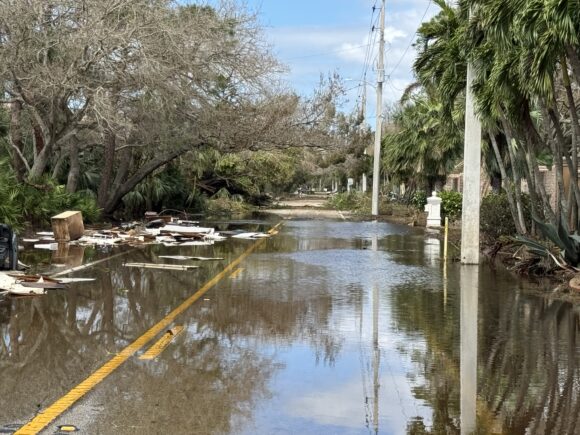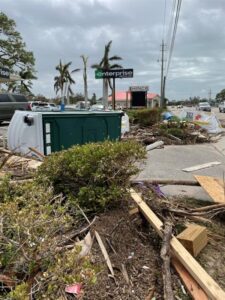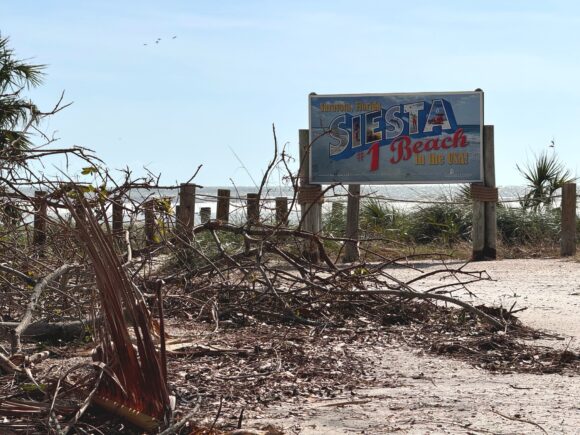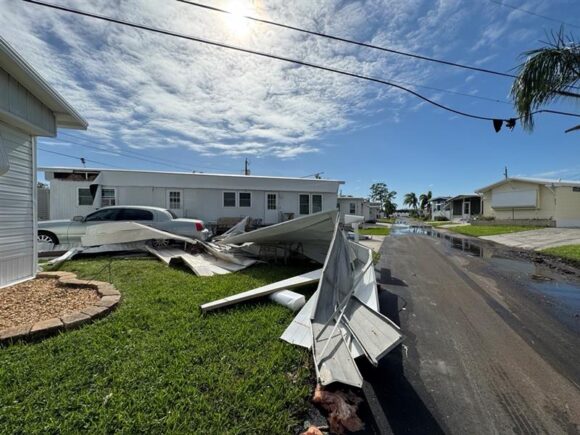Estimates released on Wednesday from CoreLogic show that insured wind and flood losses from Hurricane Milton are expected to be between $17 billion and $28 billion.
CoreLogic’s estimate comes as Moody’s RMS Event response updated its estimate, which shows total private market losses from Hurricane Milton will be between $22 billion and $36 billion, with a best estimate of $26 billion.
Their estimate represents insured losses associated with wind, storm surge and rain-induced flooding from the event. Earlier in the week, Moody’s said total U.S. private market insured losses from the Hurricanes Helene and Milton will likely range between $35 billion and $55 billion.

Verisk on Wednesday estimated that insured industry losses to onshore property from Hurricane Milton will fall between $30 billion and $50 billion.
Related: HCI Group Expects to Pay $600M to $750M in Claims from Recent Hurricanes
During a CoreLogic webinar on Thursday to discuss the impacts, Brandon Burton, CoreLogic’s senior principal of industry relations, said the effects of Hurricane Helene will make restoration of properties damaged by Milton more difficult.

“Resources are going to be taxed in there because they’re already tied down in other areas responding to other cat events that were driven by Helene,” he said. “We’ll probably see a higher-than-average trend of alternative or atypical restoration being performed in the areas impacted by Milton because those resources aren’t as available, and not only just in the contractor base but just in the equipment and other types of services that we typically need in an event like this.”
CoreLogic said in the release of their figures on Thursday the majority of losses ($13 billion to $22 billion) will be from wind.
Coastal flood losses are expected to be highest in Sarasota and areas to the south. This is coupled with rain-induced inland flood losses. The combined flood losses will account for $4 billion to $6 billion of the insured loss total.
Related: Milton’s 152,180 Claims So Far to Mean New Pressure on Reinsurance, Rate Hikes
The losses in CoreLogic’s estimates include damage to buildings, contents, and business interruption for onshore residential, commercial, and industrial property.
The flood losses include damage from both storm surge and rain-induced inland flooding. It doesn’t include damage to offshore property such as inland marine, ocean-going marine cargo and hull, and personal boats.
Insured flood losses include those covered by the private flood insurance markets and the National Flood Insurance Program. The losses do not include damage from the associated tornado outbreak.
Hurricane Milton was the fifth hurricane to make landfall in the U.S. The storm made landfall near Siesta Key, Florida on October 9 as a Category 3 hurricane with maximum sustained winds of 120 miles per hour. Hurricane Milton followed, affecting many of the same areas with damaging wind, storm surge and inland flooding.
Related: Much of Milton’s Worst Damage Came From Wind, Not Water
“Hurricane Milton was an unusual storm, causing unexpected wind and flood conditions across the state of Florida. As Hurricane Milton neared landfall, it interacted with the jet stream over the southeastern U.S. causing the winds on the northern and northwestern sides of the hurricane – generally known to be weaker – to be atypically strong,” stated Daniel Betten, director of forensic meteorology at CoreLogic. “To add to the complexity, weather gauges in coastal Florida also measured hurricane force winds over Sarasota south of where Milton made landfall, essentially creating two distinct lanes of damaging, hurricane-force winds.”

Moody’s in its estimates listed numerous factors that could influence and prolong the claims settlement process for the two storms. Those factors include:
- Complex hazard patterns: Alongside the damaging wind, storm surge, and rain-induced inland flooding, the outer rainbands of Hurricane Milton also produced damaging tornadoes in southern Florida. The storm also interacted with a mid-latitude jet over the Gulf of Mexico that resulted strong winds –one to the south of the storm associated with the tropical portion of Milton, and one that wrapped around the back of the system associated with its interaction with the jet.
- Coverage leakage across events: Preliminary reports indicate several instances where structures damaged in Helene that may have been uninsured or underinsured for flood, were also affected by high winds and wind-driven rain in Milton. It may be difficult to ascertain the proximate cause of loss in cases, which may lead to coverage leakage.
- Event Attribution: If a claim was opened after Helene and if there is additional damage in Hurricane Milton, it will likely result in a single payout, but there will be questions on which event the payout is assigned to, and the resulting impact on potential reinsurance recoveries.
Moody’s said losses for the NFIP are expected to be largely driven by storm surge, particularly in areas south of Tampa Bay-St. Petersburg. The modeler said insured wind and NFIP losses will be driven by residential lines, while storm surge and inland flood losses to the private market will be driven by commercial and auto lines.
“Alongside damaging wind, storm surge, and precipitation-induced inland flooding, the outer rainbands of Hurricane Milton also produced numerous damaging tornadoes across Florida,” stated Jeff Waters, Director – North Atlantic Hurricane Models, Moody’s. “Damage surveys by the National Weather Service are still being conducted, but even the confirmed data to date suggests that Milton produced one of the most prolific tornado outbreaks associated with a tropical cyclone in recent history.”
Was this article valuable?
Here are more articles you may enjoy.


 ‘Dream Is in Sight:’ Chamber, Reinsurers, Insurers Urge Florida to Stay the Course
‘Dream Is in Sight:’ Chamber, Reinsurers, Insurers Urge Florida to Stay the Course  Thailand’s Record Floods Paralyze Key Hubs for Tech and Car Parts
Thailand’s Record Floods Paralyze Key Hubs for Tech and Car Parts  Atmospheric River to Flood Pacific Northwest Through Week
Atmospheric River to Flood Pacific Northwest Through Week 